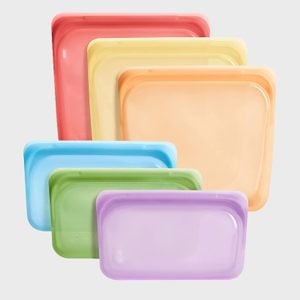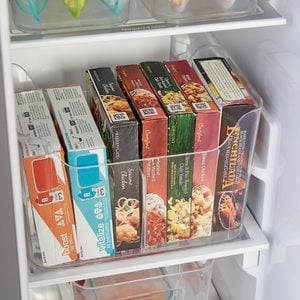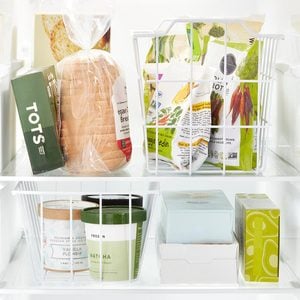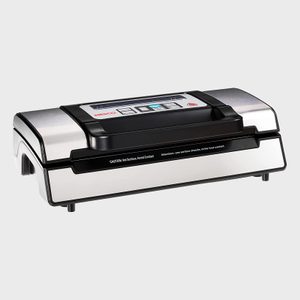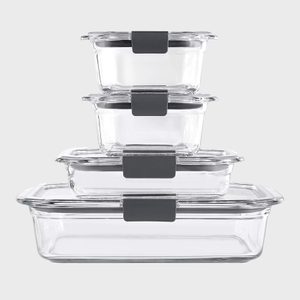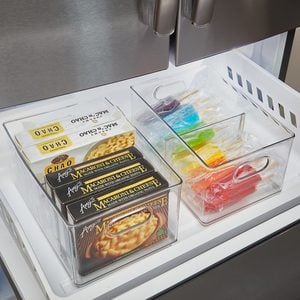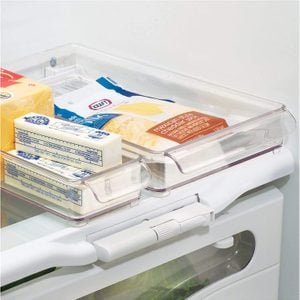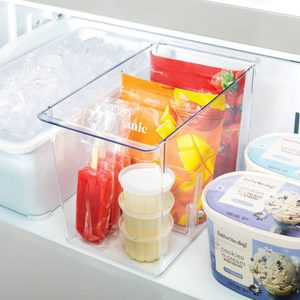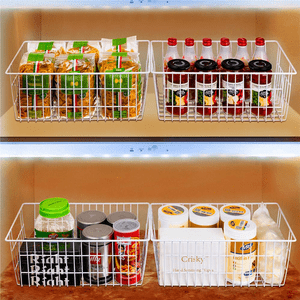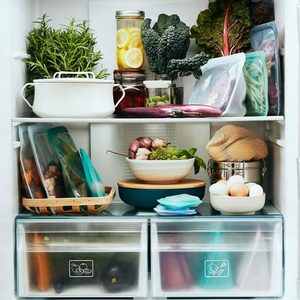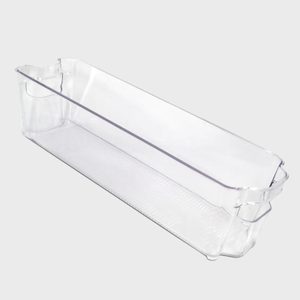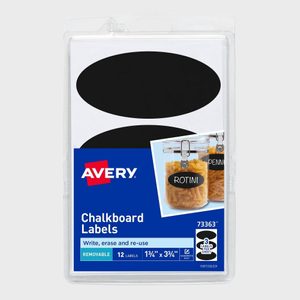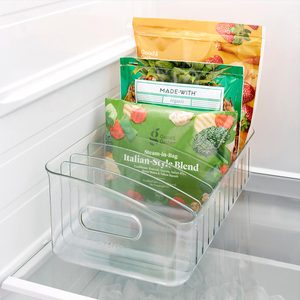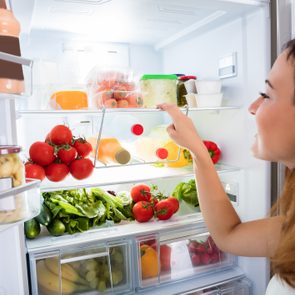How to Organize Your Freezer and Keep It Clutter-Free
Updated: Jun. 02, 2024
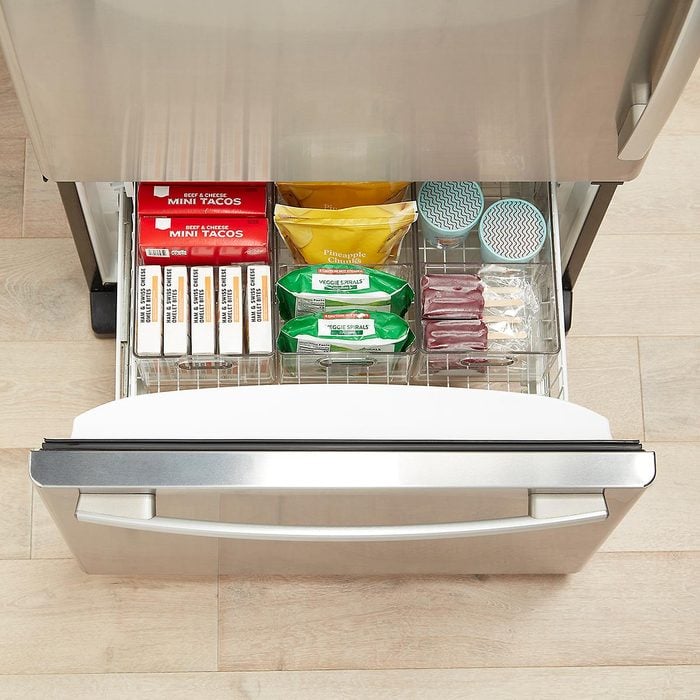
Organizing the freezer is easy when you follow these tips from professional organizers
The benefits of kitchen organization go way beyond aesthetics. Organizing the freezer and keeping it clutter-free can help you more easily stock up on your favorite freeze-worthy foods by getting rid of the guessing game of what’s hidden in the freezer’s depths. And it makes grabbing things out of the freezer a breeze—no more wondering where that frozen chicken ended up or unearthing freezer-burned ice cream that should have been tossed months ago.
“You’ll be able to keep track of all the food you have on hand to help with meal planning, and you are less likely to lose food in the back or buried under other items,” says Laura Barnes, a California-based professional organizer. That can save you money too, because you’re less likely to buy frozen goods you already own. Another benefit of organizing the freezer? By using the right food-storage containers, you can reduce freezer burn.
But as we all know, learning how to freeze food is a cinch; it’s keeping it neat and tidy that’s the challenge. So when it comes to organizing the freezer, where do you start? Thankfully, the process is as easy as (frozen) pie with our thorough guide to organizing a freezer. We have simple freezer-organization ideas for everything from organizing a chest freezer to picking out the best freezer organizers—all straight from the organizing experts. And when you’ve mastered the frozen-foods section of your appliance, turn your eye to fridge organization and the best refrigerator organizers you can buy.
Organization tips for all freezers
Even if you’ve mastered fridge organization and pantry organization, the freezer can be notoriously tricky to keep clutter-free. But as organizing pros can attest, there are some useful steps you can take to make the process less painful, no matter what type of freezer you’re working with.
Start with a clean slate
You can’t properly organize a freezer until it’s empty. So the first step is to make sure you have a cooler nearby to house anything that’s perishable while you get to work.
Then empty out the freezer completely. “Cleaning out your freezer is the most important first step,” Barnes says. “You’ll be able to see all the space you have to work with, be able to take measurements for any products you want to use, and you can get rid of any freezer-burned or expired items or food you know you just won’t eat.”
Want to take this cleaning project to the next level? Defrost the freezer and give it a good cleaning before organizing.
Label everything
The No. 1 rule of organizing the freezer is making sure everything is in plain sight. If you can see it, you’ll defrost and eat it. But when it comes to containers and freezer bags, you may not be able to see or recognize what’s inside. That’s where labels—the poster boy of organizing—come in handy.
“For freezer bags, you can simply write on them with a Sharpie what’s in the bag, how much and the date you froze it,” Barnes says. “You can also use labels with the same information on hard-sided containers. If you know what is in the container and how long it’s been there, you are more likely to use it.”
Create zones in your freezer
If you’ve ever watched Tidying Up with Marie Kondo or The Home Edit, you know all about the benefits of creating zones. Every item has a “home,” right? Well, according to the experts, the freezer is no exception.
“Zones are specific areas in your freezer where certain foods will be stored,” Barnes explains. “Create zones specific to your family and the food you eat. Examples could be veggies and fruits, meat, frozen meals, leftovers, etc.”
Keep an inventory list
The best way to stay organized is to know what you have. Creating a freezer inventory can also help you save money, because you won’t be unnecessarily buying duplicates.
“If you think you won’t be able to remember everything you have in your freezer, keep a list on the side of your fridge, organized by category, with the items you have on hand,” Barnes says. “When you use something, cross it off. And when you add something, make sure you write it on the list.”
If that sounds a little low-tech for you, you can always download a list-making app to keep the tally digital and shareable with other household members. Bonus: Keeping a list and checking it twice can help you fill gaps in your diet and allow you to add more heart-healthy and cancer-fighting foods to your meal planning.
Put organizational products to good use
For the most organized freezer—and the best chances of keeping it that way—make use of products aimed at all your organizational needs. Larger bins can house odd-sized items, for instance, and glass storage containers can hold leftovers while giving you a peek at what’s inside.
“Using products like bins and dividers in your freezer can help you keep similar items together and organized,” Barnes says. “Make sure you measure your freezer before you go and buy something, to ensure it fits.”
Toss the box
Plenty of frozen food items come wrapped in bags and then packaged in a box. Sure, that makes them easier to buy in bulk at the store, but it can hinder you when organizing the freezer. So go ahead and toss the big, bulky outer box. “You can store the bags of food in a bin,” Barnes says. “I would also cut out the cooking instructions and clip them to the bag.”
Hillary McGuigan, vice president of marketing at food storage brand Stasher, agrees. “If possible, I try to take everything out of large and cumbersome boxes,” she says. “I also freeze leftovers, soups and stocks, fruit or veggies in Stasher Bags—my personal favorite for freezer storage is our Half Gallon. Be sure to lay it flat while it’s freezing. But once frozen, you can stack them or lay them on their side to maximize your space. You can also easily label by taking a chalk marker and writing the contents and dates directly on the Stasher itself to identify its contents.”
Don’t want to shell out for reusable bags? You can follow the same advice with zip-close plastic bags.
Organize by expiration date
Buying in bulk can be economical, especially if you have a larger family. But you’ll end up throwing away money if you don’t follow the first in, first out rule. What that means: Organize the freezer so that items that will expire first are at the front and will be the first you’ll grab.
Organizing by expiration date is one of the most efficient ways to make sure you eat frozen goods before they go bad. If something expires in just a few weeks, you don’t want to hide it in the back, do you?
“This way, you can rotate out expiring items first and will reduce food waste,” Barnes says.
Aim for airtightness
Choose food storage containers that eliminate as much air around the food as possible. “Circulating air around the food causes freezer burn,” Barnes explains. “A vacuum sealer is a great tool to have if you freeze a lot of food.”
Store items vertically
In a tight space like a freezer, you have to work with all the room you’ve got—including the vertical space.
“Freezing mashed banana, chopped fruit, leftover cooked meat, leftover sauces and soups flat in a freezer bag and then storing vertically is a great way to maximize space in the freezer,” Barnes says. “Vertical storage is also more efficient. If you are stacking boxes on top of each other, when you go to pull them out you have to lift the others, and things may fall. It’s way easier to just find what you want and pull it out, like books on a shelf.”
Organization tips for top freezers
If your freezer is located above your fridge, you’ll want to put a few other expert-approved tips into action to make sure you’re organizing the freezer in the most efficient way possible.
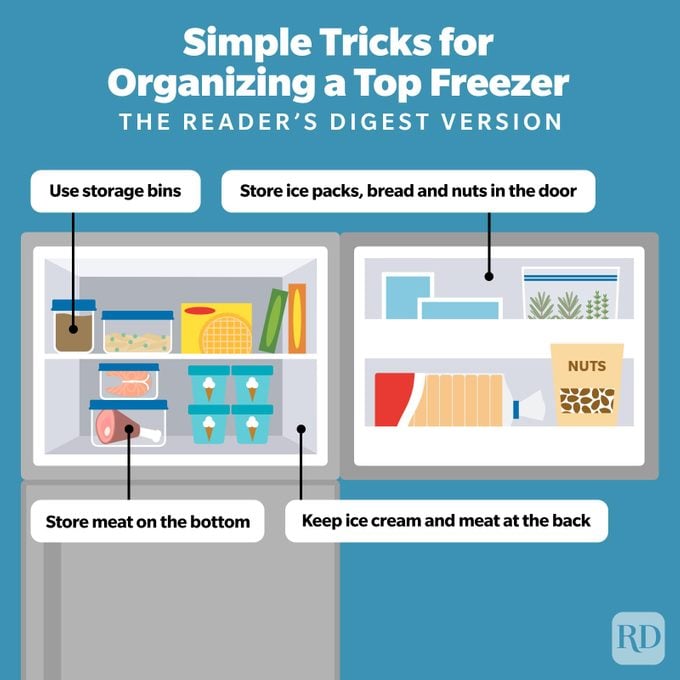
Store meat on the bottom
Because meat raises the risk of contamination and foodborne illness, you’ll want to follow proper meat storage guidelines. “Store food on the top shelf so that if it were to leak it wouldn’t contaminate the food underneath,” Barnes says. “So things like fruits and veggies on top, and meat on the bottom.”
Organize the freezer this way, and fresh meat that hasn’t had a chance to freeze won’t leak all over the fruit for your morning smoothies. And if you lose power, your frozen meat won’t thaw and contaminate the foods below it.
Use storage bins
It can sometimes be difficult to see the full contents of a top freezer, especially if you’re, uh, vertically challenged yourself. By using organizational products, you make using the freezer an easier experience.
“Use bins for each category of food so they are easy to pull out and [you can] grab what you need, like a drawer,” Barnes says.
Be strategic about freezer door storage
You may have heard this one before, but the door isn’t exactly the coldest part of a freezer because it’s constantly opening and closing. So while the body of your freezer may be at an ideal temp, items stored in the door can be subject to thawing.
“It’s not ideal for things like ice cream that can thaw and refreeze, changing the texture,” Barnes explains. “Store things like ice packs, bread and nuts on the door.”
Store ice cream and meat in back
Ice cream has a tendency to thaw and refreeze when the temperature isn’t stable, and when it does, the texture changes. You’ll want to keep it in the coldest part of the freezer. Store meat there too, because it’ll help maintain food safety.
“The center in the back is the coldest, so this would be the best place for ice cream and meats,” Barnes says.
Organization tips for drawer freezers
There may be a lot of storage space in drawer freezers that pull out from the bottom of a fridge, but left untended those drawers can easily become a messy pit of half-hidden food. “I have a drawer freezer, and it’s probably the hardest type of freezer I’ve had to organize,” Barnes says. That said, there are steps you can take to maximize space and make it easier to find what you need.
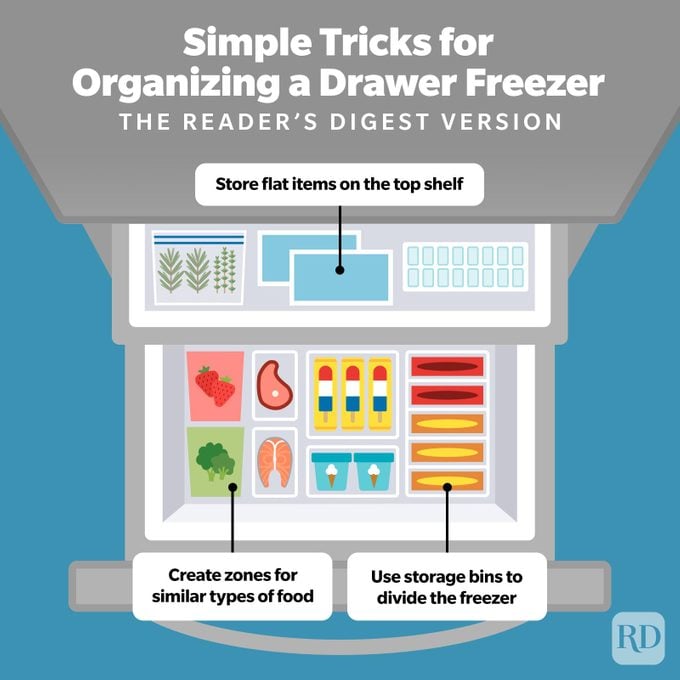
Use zones and bins to your advantage
To avoid losing frozen foods in a seemingly bottomless pit of frozen goods, focus on creating zones that match your needs. Storage bins can help you further divide the freezer for optimal organization. “I create zones, and I use bins to keep each type of food together,” says Barnes. “One bin for bags of veggies, ice packs, bags that I’ve taken out of the boxes, all stored vertically in the bins.”
Another tip: Try keeping leftovers in glass storage containers (yes, you can put glass in the freezer!), which you can stack on top of one another with the earliest expiration dates at the top.
Store flatter items on the top shelf
Depending on your refrigerator brand, your freezer drawer may include a shallow drawer or shelf on the top for additional items. “I use the shallow top shelf for leftovers frozen flat, breads and baked goods,” Barnes says. You can also group bags of frozen foods (think veggies and french fries), turn them on their sides, and store them in a line in the top section. If your top drawer is especially shallow, put flat items, like ice packs, here.
Don’t let this top shelf go to waste! Make use of that vertical space! Stacking clear organizers is a great way to do it.
Organization tips for side freezers
Also known as the skinny freezer, these appliances come with a downside: Many owners complain that there’s just not enough room. But while this type of freezer poses its challenges (there may be more shelves, but they’re usually narrow), we promise it’s possible. The best way to organize a side freezer? Treat each of those shelves as a zone. And if all else fails, store a mini freezer in the basement for all the frozen foods you don’t plan to eat immediately.
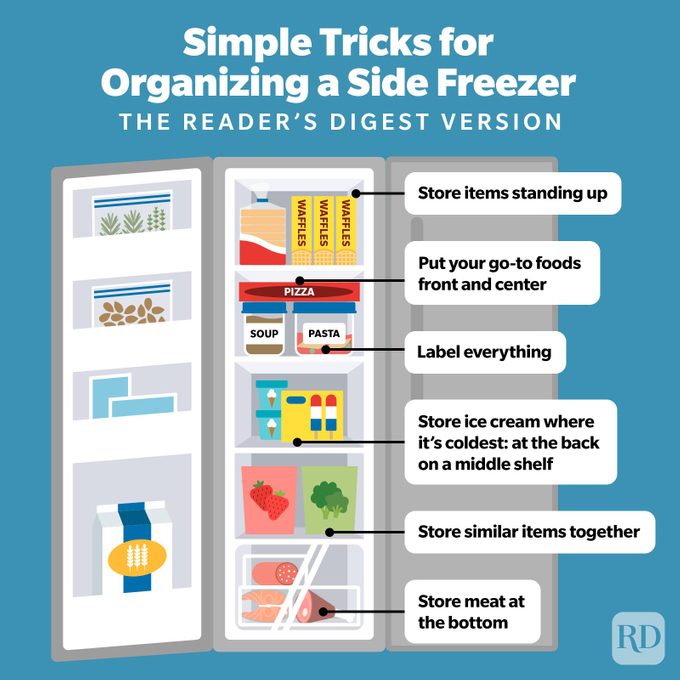
Organize based on your needs
Before you start shoving food in the freezer willy-nilly, consider what you eat and what you want to eat (you know, those healthy foods nutritionists stock their fridges with). Then make those items easy to grab.
“My personal opinion is that it somewhat depends on the shape and size of your freezer,” McGuigan says. “What do you access the most or need visibility to see? Place those items in a spot for easy access and visibility. Place the items you don’t regularly access toward the back.”
Use the zone method
Your method for organizing the freezer will depend on your preferences, but keep the zone method in mind, grouping like items in various areas of the freezer. Here’s a good layout to get you started:
- Top shelf: Place bread and baked goods, plus other breakfast-related items like waffles and Just Egg, at the top.
- Second shelf: Use bins to divide up your soups, sauces, leftovers and prepared frozen meals. Any frozen pizzas can go on top.
- Third shelf: Add ice cream, ice pops and other frozen desserts.
- Fourth shelf: Store frozen fruits and vegetable bags.
- Bottom shelf or bins: Frozen meat should always go on the lowest shelf or in the storage bins at the base.
Store items standing up
Stacking bags of fruits and veggies on top of each other seems like a good space-saving idea, but it’s a surefire way to have things come falling out every time you open your freezer door. Instead, stand bags in a line on their sides or bottoms. It’ll be easier to see what you have and access what you need.
Label everything
You know that sealed container of leftover something that’s been sitting in your freezer since … forever? There’s a reason you haven’t eaten it: You have no idea what it is.
Labeling is the prime tip for just about all kinds of organization, but it really comes in handy with a side freezer. Because they tend to be deep with narrow shelves, side freezers make it easy to shove items into the back—and then forget about them. By labeling your food containers, you give yourself a leg up when scouring the freezer.
Keep temperature zones in mind
All freezers have temperature zones, but they’re especially important to consider if you have a side freezer. Remember, regularly opening it can raise the temperature of the items stored in the door, and side freezers have a good amount of door storage. Store items like flour, bread, butter, ice packs, nuts and tomato paste in this area. You can also store fresh herbs that have been frozen here.
The middle shelf in a side freezer is the perfect spot for things that need to stay coldest, including ice cream, ice pops and other frozen desserts. Leave the bottom shelf for the meat. It’s one of the coldest zones, and the bottom location will prevent juices from dripping onto other foods while your meat freezes. Many fridges even have built-in fish- and meat-specific storage bins at the bottom for this purpose.
Get Reader’s Digest’s Read Up newsletter for tips on cleaning, travel and tech, plus humor and fun facts, all week long.
Sources:
- Laura Barnes, professional organizer and founder and CEO of Let Laura Jean
- Hillary McGuigan, vice president of marketing at food storage brand Stasher




















